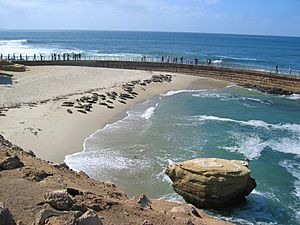Children's Pool Beach facts for kids
Children's Pool Beach is a small sandy beach in San Diego, California. It's located at 850 Coast Boulevard in La Jolla. This beach got its name because it was designed to be a safe place for kids to swim, protected from big waves.
In 1931, a kind person named Ellen Browning Scripps paid for a concrete wall, called a breakwater, to be built. This wall created a calm, protected area for children to play and swim. The state government even made a law in 1931 to confirm this gift to the community.
However, since the mid-1990s, a group of harbor seals has made Children's Pool their home. This has led to a lot of discussion and disagreement about whether the beach should be mainly for people or for the seals.
Contents
Seals at Children's Pool
How the Seals Arrived
People started noticing more seals in the area around 1992. By 1994, the city created a special "Marine Mammal Reserve" to protect marine animals. This reserve was set up for five years and then renewed.
At first, seals mostly stayed on nearby rocks. But by 1996, more seals were using the beach at Children's Pool itself. In 1999, baby seals, called pups, were born on the beach for the first time. This happened because the number of seals was growing all along the West Coast.
Beach Use and Rules
In 1997, the city closed Children's Pool for swimming because of high levels of bacteria in the water. This bacteria came from seal waste. This started a big debate: Should the beach be a home for seals, or should it be kept open for people to swim?
The California Coastal Commission, a group that manages California's coast, said that Children's Pool must stay open for public use and cannot be just a seal sanctuary. However, the National Marine Fisheries Service (NMFS), which protects marine life, later said it would manage the area as a natural resting and breeding spot for harbor seals.
By late 2009, about 200 harbor seals were regularly using the beach. These seals became a popular attraction, bringing many tourists and helping local businesses.
Legal Decisions and Changes
Over the years, many legal cases and state laws have tried to decide the future of Children's Pool.
In 2005, a judge ordered the city to clean up the beach and fix the bacteria problem. This decision was upheld by an appeals court in 2007.
However, in 2009, California's governor signed a new law. This law allowed the San Diego city council to decide if the beach could also be used as a marine mammal sanctuary. This meant the city council could choose to make it an official seal sanctuary. The city council then decided they wanted to keep it a seal sanctuary.
A judge later overturned previous orders that forced the city to remove the seals. This decision meant the seals could stay, especially with the new state law coming into effect.
In 2010, the city council approved a plan to close the beach to people from December to May, which is when seals have their pups. They also planned to install a rope barrier year-round to keep people from getting too close to the seals. This plan also said dogs would not be allowed on the beach.
In 2013, a judge and the California Coastal Commission approved a year-round rope barrier. This barrier helps keep people from getting too close to the seals, but it still has a small opening for people to access the water from the beach. This rope barrier was still in place in 2019.
Current Situation at the Beach
Lifeguards and people who support the seals watch over the beach. Swimming is allowed, but it's not suggested because of the high amount of bacteria from seal waste.
The city puts up a rope barrier from December 15 to May 15. This is to protect pregnant seals and their newborn pups during pupping season, which is usually from mid-January to mid-April. This rope barrier is "advisory," meaning it's a suggestion to keep a distance, and there's still an opening for people to pass through to the water.
Lifeguards warn that seals and sea lions are wild animals. They can be unpredictable and might bite if they feel threatened. Sea lions, especially, can be aggressive and should be given plenty of space.
In 2013, a camera was installed on an old lifeguard tower to watch the seals and how people interacted with them. Soon after, videos showed people bothering the seals. Because of this, the mayor ordered Children's Pool to be closed at night to protect the pregnant seals and their pups.
The long-running debate about the beach has even been featured on a radio show called This American Life, which talked about the disagreements between seal supporters and beach visitors.
See also
 In Spanish: Children's Pool Beach para niños
In Spanish: Children's Pool Beach para niños


